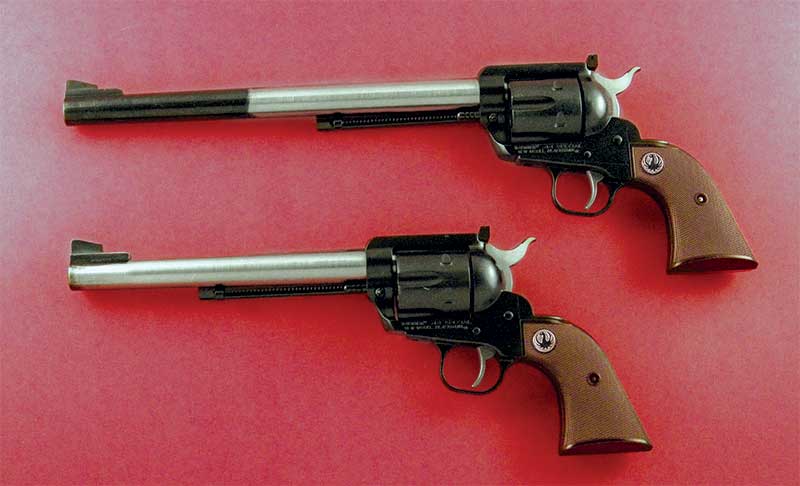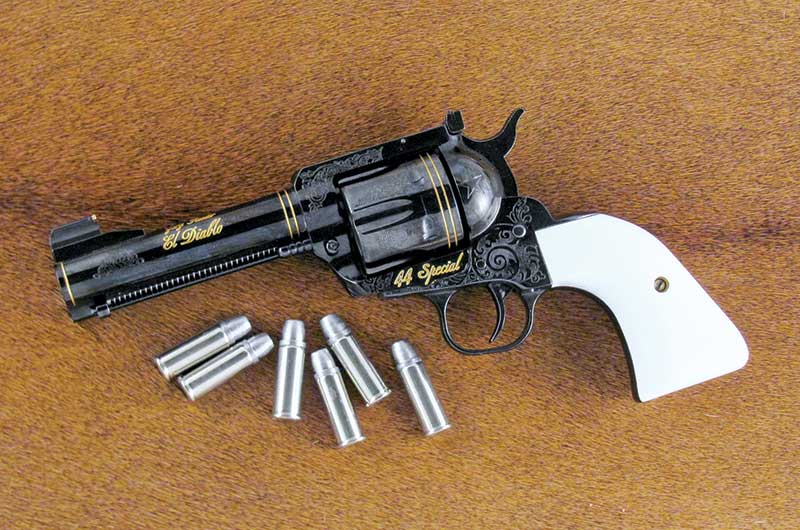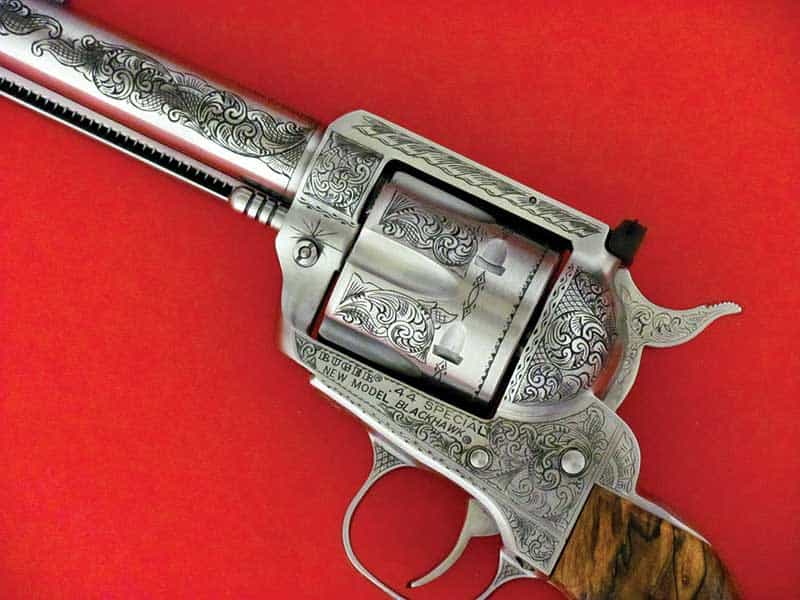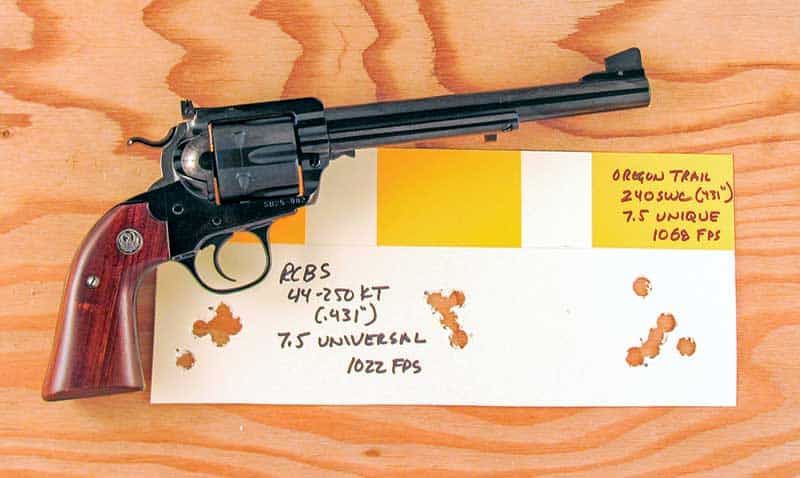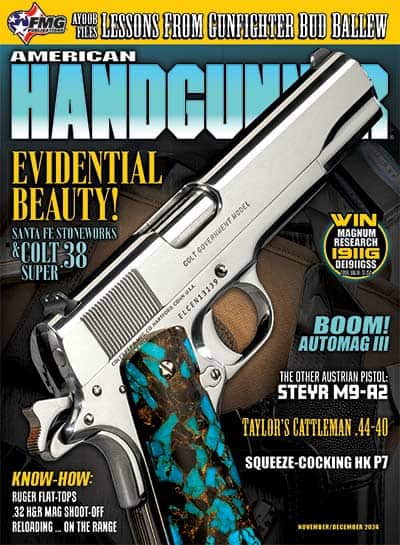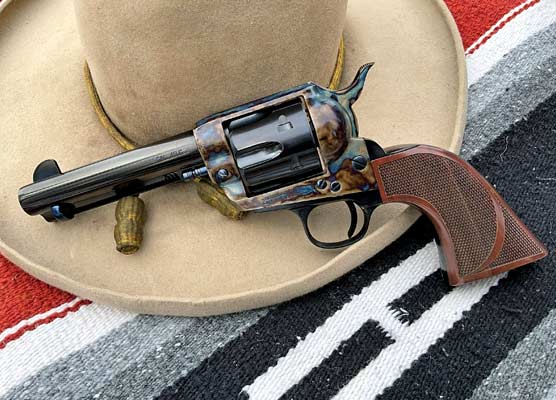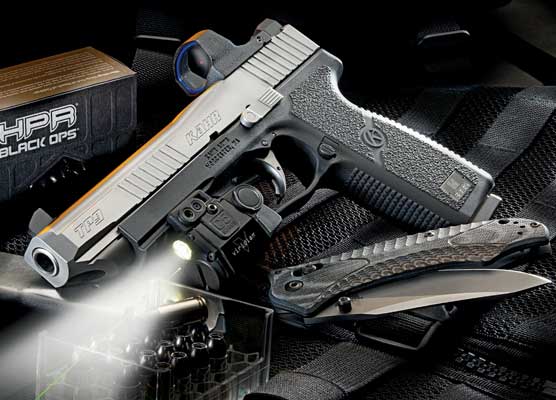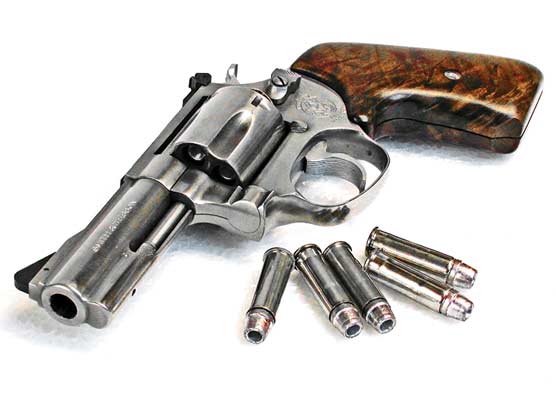The Era Of The .44 Revolver
Ruger Flat-Top Sixguns
In 1955, Ruger introduced their first centerfire single-action sixgun, the .357 Magnum Blackhawk. This Colt-size single action, just as with the 1953 Single-Six .22, was powered by coil springs and also had a grip frame identical in size and feel to the legendary Colt Single Action. Bill Ruger flat-topped the frame of the Blackhawk and added excellent adjustable sights. At the time, the .357 Magnum was the most powerful cartridge available and the Blackhawk quickly became a favorite with shooters and outdoorsmen.
In his 1955 book, Sixguns, Elmer Keith introduced the .357 Magnum Blackhawk and also said: “… the .357 Ruger is one honey of a gun and amply heavy for the .357 and .44 Special …” The .357 Magnum was the most powerful factory-loaded cartridge available. However, handloaders had been shooting 250–260 grain hard-cast bullets in the .44 Special at 1,100–1,200 fps for nearly 30 years. It was almost a foregone conclusion the Blackhawk would soon be chambered in .44 Special. However, Bobby Burns proved once again to be correct, and the best-laid plans of mice and men went awry.
While Ruger was working on the .357 Magnum Blackhawk, S&W and Remington were secretly experimenting with what would soon become the .44 Magnum. The first of the .44 Magnums from S&W were released from the factory in December 1955. By early spring, Ruger was re-chambering the .357 Blackhawk to three prototype .44 Magnums. Upon further testing one of these let go so the engineers at Ruger increased the size of the frame and cylinder; the .44 Magnum Ruger Blackhawk was born and the .44 Special chambered in a .357 Blackhawk-sized single action was forgotten.
Flat-Top Three-Screw
Ruger would produce a .44 Magnum Blackhawk, now known to collectors and shooters alike as the Flat-Top Three-Screw Model, from 1956 to 1962, when it was removed from production. In 1959 it was “improved” as the Super Blackhawk. The barrel length of the original was increased from 6½ to 7½”, the rear sight received protective ears machined into the frame, the cylinder was unfluted, and the grip frame was changed from an aluminum Colt-sized affair to an all-steel grip frame patterned after the Colt 1848 Dragoon complete with square back trigger guard. In 1972, as with all other Ruger Blackhawks, the Super was further modernized with what is now known as the New Model action, complete with a transfer bar allowing it to be safely carried with six rounds instead of the old traditional way of always having the hammer resting on an empty chamber.
At first, I did not care that much for the New Model action — it just did not feel right to me. Over the years, I have come to realize this was a very smart move on Ruger’s part, preventing who knows how many negligent discharges. However, there are any number of gunsmiths who can smooth it up beautifully plus, I have to admit I like the idea of being able to carry a sixgun as a real sixgun and not a five-gun.
Ruger has introduced 50th Year Anniversary versions of the .357 Blackhawk, 2005; .44 Blackhawk, 2006; and .44 Super Blackhawk, 2009. I, of course, had to have all three. I have had several of the .357s converted to .44 Special and just received a new Model .357 Blackhawk, a special 10″ Commemorative from the Ruger Collectors Association. While I left my Anniversary Super Blackhawk strictly as issued, I had to do the same thing to the New Model .44 Magnum Blackhawk as I did to one of the originals more than 50 years ago; the barrel was cut to 4¾” using an old original Flat-Top .44 Magnum barrel turning it into a prime candidate for the title of Perfect Packin’ Pistol.
Factory .44s
Of course, the big news for me was to finally see a factory-produced Ruger .44 Special Blackhawk. This finally came about 53 years later, with the offering of two .44 Special New Model Flat-Top Blackhawks by Lipsey’s. Those first two were offered in barrel lengths of 4⅝” and 5½”, and of course, after waiting so long, I had to have one of each. These proved to be excellent sixguns, well-timed, tightly fitted, and with uniform chamber throats of 0.431″, making them perfect for shooting .44 Specials. Not only had Lipsey’s done what Ruger had never accomplished, but their action even spurred Ruger to finally catalog .44 Specials. And in 2009, Ruger made these two sixguns standard production items.
Special Specials …
In late 2009, I received three of the Ruger .44 Special Blackhawks, and since I already had two Lipsey’s .44 Specials, I decided to do something really special with these Specials. First, I contacted my friend Gary Reeder to see if he had a 7½” or 10½” take-off barrel from a Ruger Super Blackhawk. He had both and sent them up to me. I had my local gunsmith, Tom Cripe at Buckhorn, polish the warning labels off both of these barrels and fit them to two of the Ruger .44 Specials. The next step was to shoot them and see if they were going to be everything I wanted, and when this proved out both sixguns were sent to Gary Reeder to be personalized with “John Taffin The Sixgunner” on the barrels and refinished. No one is any better at bluing sixguns than Gary, and both of my new Long Range Rugers turned out beautiful, but I didn’t stop there.
What about that third .44 Special Ruger New Model? It also went to Reeder Custom Guns to be turned into what Gary calls his El Diablo package. The grip frame was slightly round butted and fitted with Corian Ivory grips, the original barrel was given a deep dish crown, an interchangeable front sight system was fashioned, sights were changed to a gold bead front, and an express rear, gold embellishments were added along with “El Diablo,” and the whole thing was also beautifully re-blued. The result is one devil of a great sixgun. For my personal use, I had to make a change; I simply do not shoot express sights as well as I do standard sights, so both the front and rear sights were changed to adhere to my personal idiosyncrasies.
More Lipsey’s
Meanwhile, back at Lipsey’s, more great .44 Special things were happening. To follow up on their two original .44 Specials, Lipsey’s offered the same barrel lengths in a Bisley Model. The organization I started 25 years ago, The Shootists, was looking for a suitable 25th Anniversary sixgun and working with Ruger and Lipsey’s, the committee came up with a 7½” Bisley Model .44 Special. These are all appropriately marked as 25th Anniversary sixguns and also finished in bright blue. Only 100 of these were made and only went to members of The Shootists. Mine has proven to be an excellent shooting sixgun.
In 2010, Lipsey’s went stainless steel .44 Special. The first offering was a 4⅝” Flat-Top Blackhawk. Just as with all of their other .44 Specials, this is built on the original .357 Blackhawk-sized frame also with the original-sized XR3 grip frame. I was so smitten with the first one to come into Buckhorn I grabbed it before they had it completely unpacked. And then, without even shooting it, I sent it up to Michael Gouse in Montana to be C-engraved. It turned out beautifully. To make it even more of a special Special, it shoots as well as it looks with one-hole groups using the Lyman/Thompson #429215GC bullet at 1,085 fps. Even with the stainless-steel Blackhawk, Lipsey’s did not just sit back but also offered the New Vaquero in the stainless steel .44 Specials in both a standard 4⅝” version as well as a 3½” Sheriff Models, as we shall see in a future story. It took more than half a century, but at last, Ruger was building .44 Specials. Sometimes, progress is not all that bad.
For info: Ruger.com, ReederCustomGuns.com, GouseFreelanceFirearmsEngraving.com



